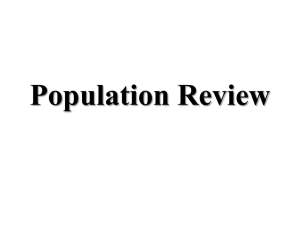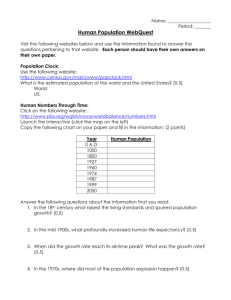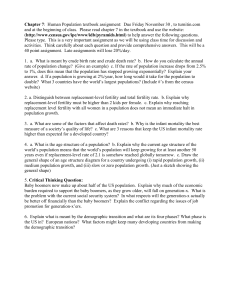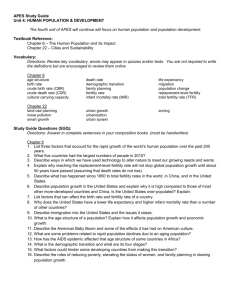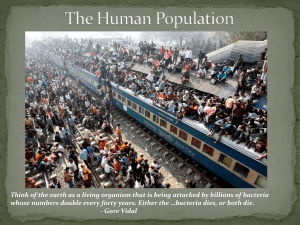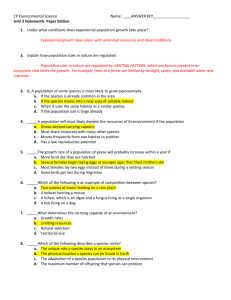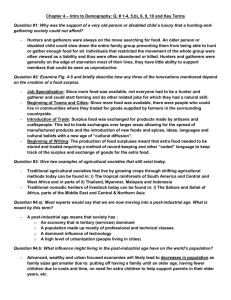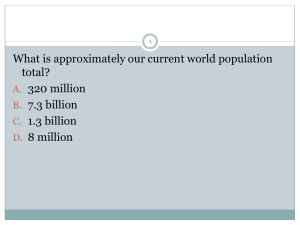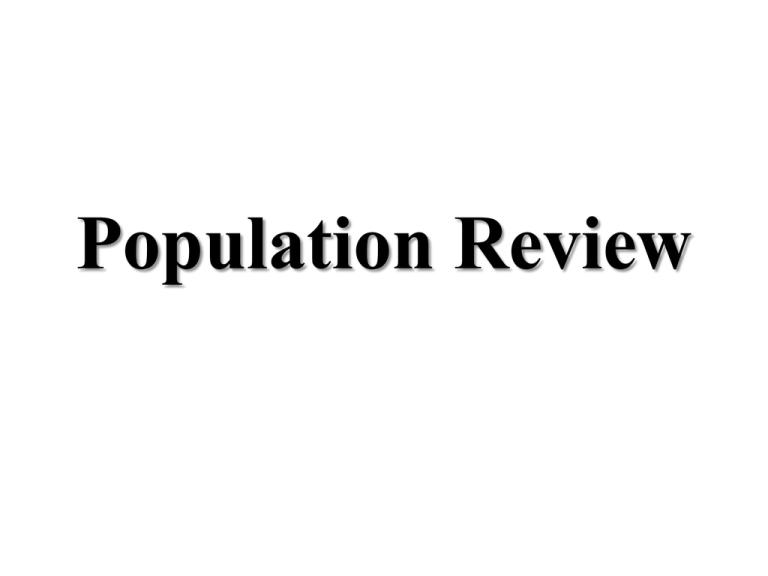
Population Review
When natural selection occurs, what is the
key factor that will determine which
individuals will survive and pass on the
beneficial traits?
A. The traits that are more useful to humans
will be passed on
B. Size; the larger the animal or plant, the
more likely it will survive
C. How large the initial population is
D. The environment will determine which
traits are most beneficial
E. Natural selection is random and occurs by
chance
If a population of 100 birds increases
to 120 birds the following year, r =
_____.
A. 0. 16
B. 0. 20
C. 1. 2
D. 2
E. 20
Population A
I. Is likely to have a higher level of education
than population B
II. Is likely to have had a recent decline in infant
mortality
III. Is likely to be poorer than population B
A. I
B. III
C. I and II
D. II and III
E. I, II, and III
A population of rabbits, introduced to
an island, has rapid growth for a few
years; then its growth slows. The
population becomes stable because
A. the carrying capacity has been
reached.
B. environmental resistance declines.
C. immigration is reduced.
D. r declines.
E. Bergman’s Principle takes effect.
Countries undergoing rapid
population decline may experience a
rise in the proportion of the population
A. on “social security”.
B. consuming a large fraction of
medical services.
C. who are older people.
D. can face labor shortages.
E. who fit all of these answers.
Rapidly growing countries have an age
structure that
A. forms an inverted pyramid.
B. has a broad-based pyramid.
C. shows little variation in population
by age.
D. has a large postreproductive
population.
Countries that have achieved ZPG
have an age structure that
A. forms an inverted pyramid.
B. has a broad-based pyramid.
C. shows little variation in population
by age.
D. has a large prereproductive
population.
E. has a large reproductive population.
An exponential growth curve depicting
an ever-growing population is shaped
like the letter ____.
A. J
B. L
C. M
D. S
E. N
The age structure of a population is
the number or percentage of
A. females age 14 years or under.
B. females age 15 to 44.
C. males age 15 to 44.
D. persons of each sex at each age
level.
E. persons of each sex age 15 to 44
According to the theory of
demographic transition, rapid growth
occurs during phase
A. 1.
B. 2.
C. 3.
D. 4.
E. 5.
Two useful indicators of overall health
in a country or region are
A. birth rate and death rate.
B. replacement-level fertility rate and
total fertility rate.
C. life expectancy and infant mortality
rate.
D. life expectancy and death rate.
E. population growth rate.
Two useful indicators of overall health
in a country or region are
A. birth rate and death rate.
B. replacement-level fertility rate and
total fertility rate.
C. life expectancy and infant mortality
rate.
D. life expectancy and death rate.
E. population growth rate.
The most useful measure of fertility for
projecting future population change is
the
A. replacement-level fertility.
B. one-year future fertility level.
C. total fertility rate.
D. birth rate.
E. abortion rate.
Which of the following would contribute the
greatest number to total population size in
one year?
A. a country of 1. 5 million people with a
growth rate of 3%
B. a country of 5 million people with a growth
rate of 2. 5%
C. a country of 100 million people with a
growth rate of 2%
D. a country of 500 million people with a
growth rate of 1. 5%
E. a country of 10 million people with a
growth rate of 2. 5%
When mosquitoes are very abundant,
purple martins flock to the area and
specialize on them. When mosquito
populations are not large, purple martins
are similarly scarce and feed on other
insects. This is an example of
A. density-independent regulation.
B. density-dependent regulation
C. ecosystem carrying capacity.
D. community carrying capacity.
E. exotic regulation.
Approximately how many females
are between the ages of 50 and 59?
A. 500,000
B. 5,000,000
C. 20,000,000
D. 30,000,000
E. 50,000,000
The crude birth rate is the number of
live births per ____ persons in a given
year.
A. 50
B. 100
C. 500
D. 1,000
E. 10,000
Which of the following best
describes the survivorship curve
you would expect to find for a
Kangaroo?
A. late loss
B. constant loss
C. early loss
D. no loss
Which of the following factors
leads to an increase in biotic
potential?
A. too much or too little light
B. low reproductive rate
C. too many competitors
D. optimal level of critical nutrients
E. specialized niche
The most common pattern of
population dispersion found in
nature is
A. random.
B. clumped.
C. uniform.
D. dispersed.
Worldwide, the largest densitydependent cause of death is
A. natural disaster.
B. malnutrition.
C. heart disease.
D. infectious disease.
E. car accidents.
A country has a growth rate of 0. 2%, a TFR
of 2. 6, and a net migration rate of -8. What is
most likely true of this country?
A. The population will likely decrease over
time.
B. The population will likely grow for a few
generations before stabilizing.
C. The population will likely grow for a few
generations before shrinking.
D. The population will likely increase at a
steady rate.
E. There is not enough information to tell.
Using the rule of 70, a population
growing at 3.5% would double in
A. 7 years
B. 10 years
C. 15 years
D. 17 years
E. 20 years
According to the theory of
demographic transition, birth rates
make the most significant decline
during phase
A. 1.
B. 2.
C. 3.
D. 4.
E. 5.
Developing countries tend to have
a(n) ____ age structure diagram.
A. rectangular-shaped
B. inverted triangle
C. pyramid-shaped
D. square
E. round
To determine the number of
individuals that will be added to a
population in a specified time we
multiply the growth rate (r) by the
A. biotic potential.
B. original population size.
C. environmental resistance.
D. final population size.
E. number of immigrants.
The total fertility rate (TFR) is an estimate of
A. the number of children that will survive to
adulthood.
B. the number of years a typical infant will
live.
C. the percentage of women in a population
that are able to have children.
D. the number of births per 1000 people per
year.
E. the number of children each woman in a
population will have.
If the growth rate r of a population is
positive and remains constant, the
number of people added to the
population
A. remains constant.
B. fluctuates randomly.
C. decreases each year.
D. reaches carrying capacity.
E. increases each year.
The biologist who studies interactions at
the “community” level investigates
interactions between
A. organisms of one species
B. populations of more than one species.
C. animals of one species.
D. social animals (like insects).
E. ecosystems.
The intrinsic growth rate of a
population
A. directly affects environmental
resistance.
B. causes changes in birth rates
without affecting death rates.
C. causes changes in death rates
without affecting birth rates.
D. is the maximum rate at which a
population may increase.
According to the theory of
demographic transition, the highest
birth rates and death rates are likely to
occur during phase
A. 1.
B. 2.
C. 3.
D. 4.
E. 5.
Approximately how many males are
under the age of 10?
A. 130,000,000
B. 110,000,000
C. 20,000,000
D. 15,000,000
E. 450,000
You observe uniform dispersion in a species
you are studying intensely. You predict that as
you extend your work, you will find
A. intraspecific competition and evenly
spread, scarce resources.
B. interspecific predation and evenly spread,
scarce resources.
C. intraspecific competition and evenly
spread, abundant resources.
D. commensalism and clumped resources.
E. interspecific competition and evenly
spread, abundant resources.
Two species of aster can be found in a field in New
York, and they tend to flower at the same
approximate time in early spring. When some
ecology students decide to conduct an experiment
in community dynamics, they selectively remove
one species from the field by handpicking all
plants of that species. When the one species is
removed, the other species shows a significant
increase in its population the next season. This
study demonstrates
A. competitive exclusion.
B. niche fragmentation.
C. niche realignment.
D. resource partitioning.
E. interspecific competition

